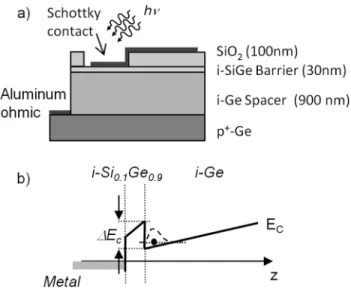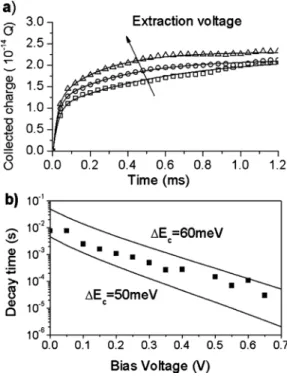Conduction band discontinuity and electron confinement
at the Si[subscript x]Ge[subscript 1−x]/Ge interface
The MIT Faculty has made this article openly available.
Please share
how this access benefits you. Your story matters.
Citation
Mazzeo, G., E. Yablonovitch, H. W. Jiang, Y. Bai, and E. A. Fitzgerald.
“Conduction band discontinuity and electron confinement at the
Si[sub x]Ge[sub 1−x]/Ge interface.” Applied Physics Letters 96, no.
21 (2010): 213501. © 2010 American Institute of Physics
As Published
http://dx.doi.org/10.1063/1.3432066
Publisher
American Institute of Physics (AIP)
Version
Final published version
Citable link
http://hdl.handle.net/1721.1/79623
Terms of Use
Article is made available in accordance with the publisher's
policy and may be subject to US copyright law. Please refer to the
publisher's site for terms of use.
Conduction band discontinuity and electron confinement
at the Si
xGe
1−x/ Ge interface
G. Mazzeo,1,a兲 E. Yablonovitch,2H. W. Jiang,3Y. Bai,4and E. A. Fitzgerald4 1Department of Electrical Engineering, UCLA, Los Angeles, California 90095, USA
2Department of Electrical Engineering, University of California, Berkeley, California 94720, USA 3Department of Physics and Astronomy, UCLA, Los Angeles, California 90095, USA
4Department of Materials Science and Engineering, Massachusetts Institute of Technology, Cambridge,
Massachusetts 02139, USA
共Received 1 March 2010; accepted 30 April 2010; published online 24 May 2010兲
Germanium rich heterostructures can constitute a valid alternative to Silicon for the confinement of single electron spins. The conduction band discontinuity in SiGe/Ge heterostructures grown on pure germanium substrate is predicted to allow the confinement of electrons in the germanium, and the conduction band profile of germanium rich heterostructures allow the implementation of g-factor modulation devices not possible in Silicon. We here prove that electrons can indeed be trapped at the Si0.1Ge0.9/Ge interface and we measure the height of the energy barrier to 0.55⫾0.05 eV by measuring the tunneling time of electrons as a function of the electric field. © 2010 American
Institute of Physics.关doi:10.1063/1.3432066兴
Single electron devices can be efficiently realized on Silicon substrates, where either metal oxide semiconductor like structures or Si/SiGe strained quantum wells1,2are used to confine electrons in the growth direction, and electrostatic gates are used for the in-plane confinement. While electrons in germanium also have long electron spin coherence time and heterostructures for electron confinement are possible, devices based on this material remain mostly unexplored. A type I band alignment is predicted3,4 from theoretical calcu-lation for Si1−xGex epilayers grown on pure germanium
when Silicon concentration is less than about 30%. Germa-nium has the conduction band 共CB兲 minimum in the 共111兲 crystallographic direction, while SiGe epilayers, due to the stress consequence of the lattice mismatch, can have the CB minimum in either 共111兲 or 共100兲 direction, if the silicon content is less or more than 10%–15%. These properties can be exploited in devices using g-factor modulation schemes, as proposed in Ref. 5 and benefiting of the total valley de-generacy lifting possible on共111兲 substrates.
One of the obstacles to the use of such devices is that the energy barrier available to confine electrons is limited to about 50–100 meV, as extracted from theoretical calculations:3,4this is consequence of the strain in the SiGe epilayer that shifts the band minima and causes the energy barrier to decrease when Silicon concentration larger than 15% is used. Besides, no experimental verification of the barrier height is available to date. In this work we want to experimentally measure the height of the CB discontinuity in a SiGe/Ge heterostructure, proving that it is possible to con-fine electrons at that interface, and measure how long elec-trons can be confined before tunneling occurs.
The heterostructure used in this work was grown with a home-built ultra high vacuum CVD system on a-Ge共100兲 共10 ⍀ cm兲 substrate. On top of that, a 200 nm thick p+layer,
with Boron concentration of 2 1018 cm−3, a nonintentionally
doped Ge layer 900 nm thick and a 30 nm Si0.11Ge0.89barrier were grown. The barrier thickness and alloy were verified by
transmission electron microscopy and secondary ion mass spectroscopy, respectively. These values are well below the Matthews and Blakeslee stability limit so that no strain re-laxation is expected. On this substrate we fabricated a Schottky diode as shown in Fig. 1共a兲, using semitransparent titanium for the blocking contact. Notoriously the metal Fermi level is pinned close to the germanium valence band,6 so that even at liquid helium temperature most metals tested, such as nickel, platinum, and aluminum gave quasi Ohmic I-V characteristics. Only titanium reliably formed a good Schottky barrier with a reverse leakage current limited to 10−8 A/cm2 up to 1 V bias. The back contact was realized
etching the spacer down to the p+ layer and depositing
alu-minum subsequently annealed at 400 ° C. The device area was limited to 100⫻100 m2 to ensure uniformity of the barrier.
As evidenced in Fig. 1共b兲, when the device is reverse biased, a triangular quantum well for electrons is formed
a兲Electronic mail: mazzeo@ee.ucla.edu.
FIG. 1. 共a兲 Schematic cross-section of the heterostructure and Schottky diode used in the work 共b兲 detail of the triangular potential well formed under the SiGe/Ge interface.
APPLIED PHYSICS LETTERS 96, 213501共2010兲
under the SiGe/Ge interface, delimited at the left 共top兲 side by a trapezoidal barrier. Being the barrier height in the 50– 100 meV range and the thickness limited to few tens of na-nometers, a considerable tunneling probability is expected.
Experiments were performed in liquid helium, to elimi-nate any thermally activated process. To detect the trapping and tunneling of electrons through the barrier we photoge-nerated electron-hole pairs by absorption of a 630 nm radia-tion: the internal electric filed is such that holes are collected at the substrate while electrons accumulate under the barrier and eventually tunnel through it and are collected at the Schottky contact. After the photogeneration electron tunnel-ing is detected by measurtunnel-ing the current flowtunnel-ing through the device. Electrons tunneling through the barrier induce a charge on the electrodes equivalent to that generated by a charge moving inside the plates of a capacitor. In our device each electron induces a total charge equivalent to tb/共tb
+ ts兲·q⯝0.03·q, where tb and ts are the thicknesses of the
barrier and spacer, respectively, and q is the electron charge. In order to maximize the available signal electrons were generated at zero bias, where tunneling is slower and a higher electron density can be obtained; detection was then performed at a larger reverse bias, to increase the tunneling probability, and therefore, the current signal. Each measure-ment sequence, depicted in Fig.2, consists of three steps: 共1兲 A large reverse bias peak is applied to the junction in
order to remove any electrons possibly present at the interface.
共2兲 The bias is set to 0 V and a light pulse is sent to photogenerate the electrons.
共3兲 The bias voltage is increased again and the photocur-rent is measured: the voltage applied in this phase, referred to as the extraction voltage, is used to control the tunneling probability.
Charging the total device capacitance of 3 pF at the be-ginning of the third step requires a charge at least one order of magnitude larger than that induced by the electrons tun-neling. To discriminate the two contributions the previous bias sequence is repeated two times, where, at the second
iteration, no light pulse is applied. The two current signals measured at each iteration are subtracted to each other and numerically integrated to obtain the charge signal generated by the tunneling of the trapped electrons.
Figure3共a兲shows typical charge versus time signals re-corded at three different extraction voltages, where the origin of the time scale is set at the beginning of the third voltage step. The experimental data are fit with a two exponential decay curve. The faster exponential has time constant limited by the amplifier bandwidth, 50 kHz for the traces reported, and amplitude proportional to the change of bias voltage at the beginning of the third step: we attribute this signal to a relatively small modification of the total device capacitance consequence of light absorption.
Conversely, the charge collected with a slower time con-stant can be attributed to electrons tunneling through the bar-rier. As expected, the risetime, corresponding to the average tunneling time, is strongly dependent on the applied bias, while the total collected charge is constant at 10−14⫾0.1
⫻10−14Q, corresponding to a density of trapped electron of
2⫻10−10 e−/cm2. The tunneling times obtained as a
func-tion of the extracfunc-tion voltage are reported as the full markers in Fig. 3共b兲.
To confirm the validity of the experiments and extract the effective height of the tunneling barrier we developed a semiclassical model to calculate the electrons tunneling time. In this model we used the physical dimensions measured for the device previously characterized, so that the only free pa-rameter left is the energy barrier height at the SiGe/Ge inter-face.
The average tunneling time ist=⌰/e, where⌰ is the
tunneling probability andethe attempt to escape frequency.
The tunneling probability for a trapezoidal barrier calculated FIG. 2. Schematic time diagram of the measurement sequence of the共from
top to bottom兲 bias voltage, illumination, and device current during the measurement. Steps from 1 to 3 are repeated twice, but only during the first iteration the laser is turned on. The current diagram schematically shows the capacitance charging current with the additional long tail observed when confined electrons are accumulated.
FIG. 3.共a兲 Time traces of the collected charge at extraction voltages of 0.3, 0.35, and 0.4 V. Symbols are experimental data and lines are the best fitting two-exponential curves.共b兲 Decay time of the electron density vs the bias voltage. Dots are experimental data while the two lines are calculated for barrier heights of 50 and 60 meV.
through the Wentzel-Kramers-Brillouin 共WKB兲 approxima-tion is, as follows:7
⌰ = exp
再
−4 3冑
2mⴱ ប2 1 qEb 关共⌬Ec− E0兲3/2−共⌬Ec− E0 − qEbtb兲3/2兴冎
,where⌬Ecis the CB discontinuity, E0the kinetic energy of
the electron in the triangular well, Ebthe electric field in the
barrier, tb the barrier thickness, and mⴱ= 0.12⫻m0 the
elec-tron effective mass in germanium.
The attempt to escape frequency can be written as the inverse of the roundtrip time of the electron inside the triangular well: e=
冑
共2E0q/mⴱm0兲共1/2w兲 with E0= 2.34兵关共qEbប兲2/2mⴱm0兴其2/3.
Whiletis generally dependent on the electron density,
for values below approximately 1010 e−/cm2the dependency
is slow and the decay of the electron density can be approxi-mated as exponential. The predicted decay times for a CB discontinuity of 50 and 60 meV are reported as the continu-ous lines in Fig. 3共b兲. The experimental data are in good agreement with the model and allow extracting a value of CB discontinuity of 0.55⫾0.05 eV, compatible with the theoretical values reported in literature. Besides, the total
charge collected experimentally is in good agreement with the limit set for exponential decay of the carrier density.
Concluding, we have proven the possibility to confine electrons in germanium rich SixGe1−x/Ge heterostructures.
The trapping of electrons at the heterointerface has been ex-perimentally measured detecting the tunneling of photoge-nerated electrons through the barrier. Experiments show a confinement time dependent on the applied bias voltage, as expected by the device model, with a maximum confinement time of 10 ms. Calculating the tunneling time with a semi-classical model and comparing the predicted tunneling times with the experimental ones, we could evaluate the CB dis-continuity at the interface of Si0.11Ge0.89/Ge, obtaining a
value of⌬EC= 0.55⫾0.05 eV.
1M. R. Sakr, H. W. Jiang, E. Yablonovitch, and E. T. Croke,Appl. Phys.
Lett. 87, 223104共2005兲.
2L. J. Klein, K. A. Slinker, J. L. Truitt, S. Goswami, K. L. M. Lewis, S. N.
Coppersmith, D. W. van der Weide, R. H. Blick, Mark Friesen, D. E. Savage, M. G. Lagally, C. Tahan, R. Joynt, M. A. Eriksson, J. O. Chu, J. A. Ott, and P. M. Mooney,Appl. Phys. Lett. 84, 4047共2004兲.
3M. Rieger and P. Vogl,Phys. Rev. B 48, 14276共1993兲. 4F. Schäffler,Semicond. Sci. Technol. 12, 1515共1997兲.
5R. Vrijen, E. Yablonovitch, K. Wang, H. W. Jiang, A. Balandin, V.
Roy-chowdhury, T. Mor, and D. DiVincenzo,Phys. Rev. A 62, 012306共2000兲.
6T. Nishimura, K. Kita, and A. Toriumi, Appl. Phys. Lett. 91, 123123
共2007兲.
7L. Schiff, Quantum Mechanics共McGraw-Hill, New York, 1968兲, p. 278.

